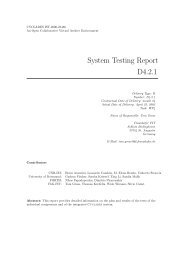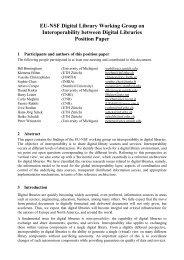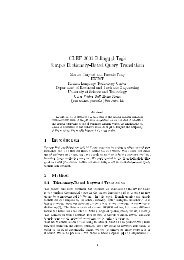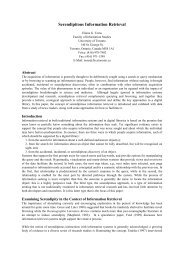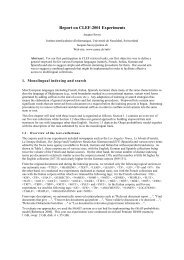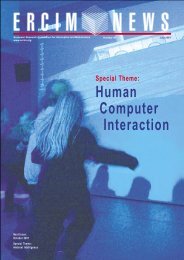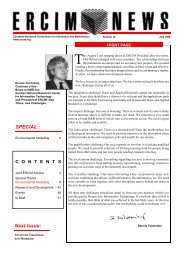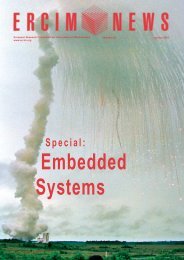Towards a Platform for Widespread Embedded Intelligence - ERCIM
Towards a Platform for Widespread Embedded Intelligence - ERCIM
Towards a Platform for Widespread Embedded Intelligence - ERCIM
Create successful ePaper yourself
Turn your PDF publications into a flip-book with our unique Google optimized e-Paper software.
Figure 1:<br />
Contacting a single molecule: Scanning electron<br />
microscope image of a metallic bridge, used <strong>for</strong><br />
establishing contact to an individual molecule.<br />
Atomic-sized tips, serving as electrodes, are<br />
created by stretching and finally breaking this<br />
'nano' bridge. The method is called the<br />
mechanically controllable break junction (MCBJ).<br />
The sketch at the top shows the switching<br />
molecule "caught" between the electrodes by<br />
closing the bridge gradually with picometer<br />
accuracy until one molecule "reaches" both<br />
electrodes. The switching molecule is a specially<br />
designed organic molecule (bipyridyl-dinitro<br />
oligophenylene-ethynylene) with dimensions of<br />
typically 1.5 nm.<br />
Promising Nanotechnology<br />
<strong>for</strong> Beyond the CMOS Era<br />
The single-molecule switch is part of a<br />
series of results achieved by IBM<br />
researchers in their ef<strong>for</strong>ts to explore and<br />
develop novel technologies that will surpass<br />
conventional CMOS technology.<br />
Miniaturizing the basic building blocks<br />
of semiconductor chips, thereby<br />
achieving more functionality on the<br />
same area, is also referred to as scaling,<br />
which is the main principle driving the<br />
semiconductor industry. Known as<br />
'Moore's Law', which states that the transistor<br />
density of semiconductor chips<br />
will double roughly every 18 months,<br />
this principle has governed the chip<br />
industry <strong>for</strong> the past 40 years. The result<br />
has been the most dramatic and<br />
unequaled increase in per<strong>for</strong>mance ever<br />
known.<br />
However, CMOS technology will reach<br />
its ultimate limits in 10 to 15 years. As<br />
chip structures, which currently have<br />
dimensions of about 40 nm, continue to<br />
shrink below the 20 nm mark, ever more<br />
complex challenges arise and scaling<br />
appears to be no longer economically<br />
feasible. Below 10 nm, the fundamental<br />
R&D AND TECHNOLOGY TRANSFER<br />
physical limits of CMOS technology<br />
will be reached. There<strong>for</strong>e, novel concepts<br />
are needed.<br />
Link:<br />
http://www3.interscience.wiley.com/<br />
cgi-bin/abstract/112713559/ABSTRACT<br />
Please contact:<br />
Emanuel Lörtscher and Heike Riel, IBM<br />
Zurich Research Laboratory, Switzerland<br />
E-mail: {eml,hei}@zurich.ibm.com<br />
Figure 2:<br />
Memory operation of the single-molecule<br />
system. The blue line shows the write, read, and<br />
erase pulse pattern applied and the red line<br />
demonstrates the resulting switching between<br />
"off" and "on" states of the molecular system.<br />
As can be seen in the picture, the system is<br />
initially in the "off" state. Then a write pulse of<br />
+1.6 V is applied and the molecule switches to<br />
the "on" state. This state can be read out using<br />
a voltage of +1.1 V. The molecule can be<br />
switched back to the "off" state by another<br />
pulse (erase pulse) of -1.6 V.<br />
<strong>ERCIM</strong> News No. 67, October 2006<br />
51




